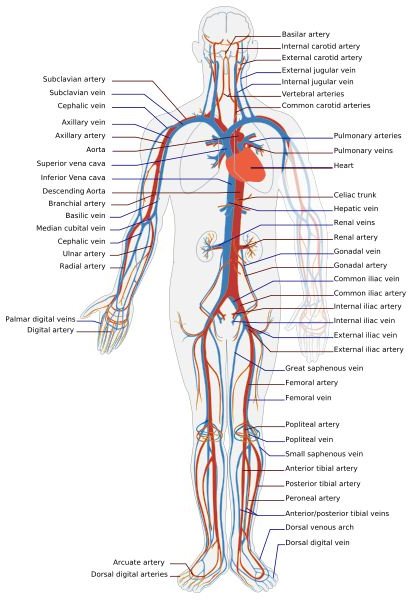Blood Vessels and the Circulatory System: Arteries, Veins and Capillaries
The Transportation Highway
Blood vessels are hollow, round tubes that act as a transportation highway for the body. Blood vessels are like little pipes that connect to the heart. The heart is like a pump that forces the blood through the blood vessels. Together, the heart and the blood vessels, make up the circulatory system.
The Circulatory System
Veins, arteries and capillaries are the three types of blood vessels in the circulatory system. The blood vessels carry blood, which contains antibodies, nutrients, oxygen, electrolytes and hormones, throughout the body to be used by the organs.
Oxygen rich blood is pumped out of the left ventricle of the heart into the aorta, which is the largest artery in the body. The oxygen rich blood travels through the aorta into smaller arteries.
The capillaries sit between the arteries and the veins, connecting the two together and acting as an exchange stop. They remove oxygen and nutrients from the blood in the arteries and distribute them to the tissues in the body. They also place cellular waste, including carbon dioxide, into the veins.
Blood, with most of the oxygen removed, travels through the veins and makes a stop by the lungs to release the carbon dioxide and re-oxygenate, before heading back to the right side of the heart, where the process starts again. The entire process of the blood traveling from the heart, through the arteries, back through the veins and back to the heart, takes approximately one to two minutes.
Artery Facts
-
Arteries carry oxygenated blood away from the heart.
-
There are three main classifications of arteries: large or elastic, medium or muscular and small or arterioles.
-
The blood in arteries is bright red in color because it contains oxygen.
-
Arteries have to be strong to withstand pressure from the beating heart. To withstand the pressure, the arteries contain elastic tissue and muscle that allow them to expand and constrict.
-
The largest arteries are closest to the heart and are about the diameter of your thumb.
-
The aorta, which connects to the left ventricle of the heart, is the largest artery in the body.
-
The smallest arteries, called arterioles, are less than 0.5 mm in diameter, meaning they are so tiny that they are barely visible to the human eye.
-
You can feel some arteries by touching your skin. Feeling the arteries is how you check your pulse. The arteries you can feel by touching your skin are the abdominal aorta, brachial, common carotid, dorsalis pedis, femoral, posterior tibial and the radial artery.
Veins
-
Veins carry blood from throughout the body back to the heart.
-
The blood in the veins is dark red in color because it contains very little oxygen.
-
The walls of veins are not as strong as the walls of the arteries because they farther away from the heart, meaning they are subject to less pressure from the heart.
-
Because veins have less muscle and elastic tissue than arteries, they do not always keep their tube-like shape and can appear flattened in some areas.
-
Veins have to push blood back to the heart, against gravity at times. Some veins have valves that prevent the blood from flowing backwards away from the heart. This ensures that the same amount of blood that left the heart through the arteries goes back to the heart through the veins.
Capillaries
-
Capillaries are the smallest blood vessels. They connect to the arteries and the veins.
-
Capillaries are extremely small tubes that average 6 to 8 micron in size; they are too small to see without a microscope.
-
Capillaries remove nutrients, including oxygen from the blood in the arteries, and distribute the nutrients to the organs throughout the body.
-
The smallest capillaries are located in the brain and the intestines.
-
The largest capillaries are located in the skin and the bone marrow.
-
Capillaries remove cellular waste, including carbon dioxide from the blood and distribute the waste into the blood in the veins, where it will be later removed.
Interesting Facts
A Whole Lot of Blood Vessels
If you laid out your blood vessels, including your arteries, veins and capillaries, in a long line, they would stretch out for about 60,000 miles long for a child and about 100,000 miles long for an adult. That is a lot of blood vessels! To get a better understanding of how long that is, the state of California is 770 miles long.
How Much Pressure
Blood pressure is measured by the blood flow in the arteries. A blood pressure has two number readings. The first number, which is the highest number, is called the systole phase. The systole phase is the blood pressure when your heart beats. The second number, which is the smallest number, is called the diastole phase. The diastole phase is the blood pressure when your heart relaxes between beats.
It’s Getting Hot In Here
The blood vessels disperse heat from the blood to the organs in the body to keep you nice and warm.
Image Credits
Circulatory System Image Credit: Wikimedia Commons/LadyofHats/Public Domain - https://commons.wikimedia.org/wiki/File:Circulatory_System_en.svg
References
- Clinical Anatomy: Applied Anatomy for Students and Junior Doctors 11th Edition; Wiley-Blackwell; November 17, 2006
